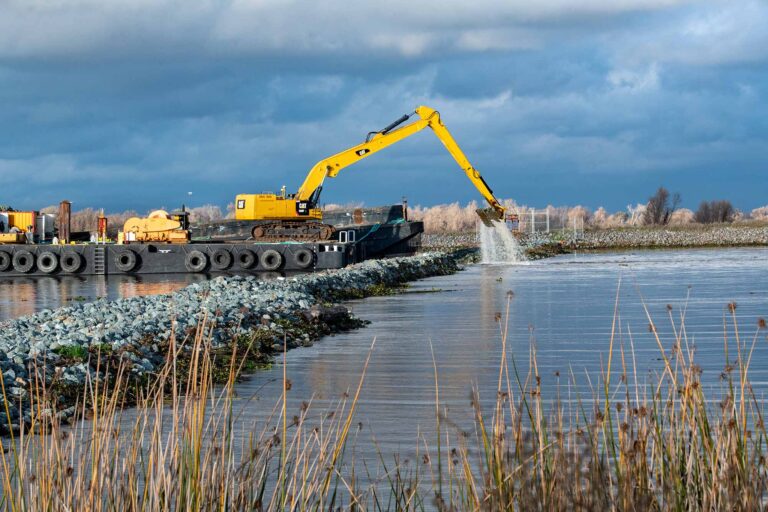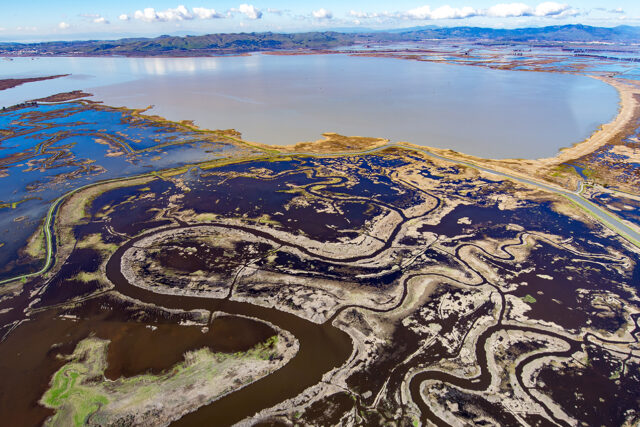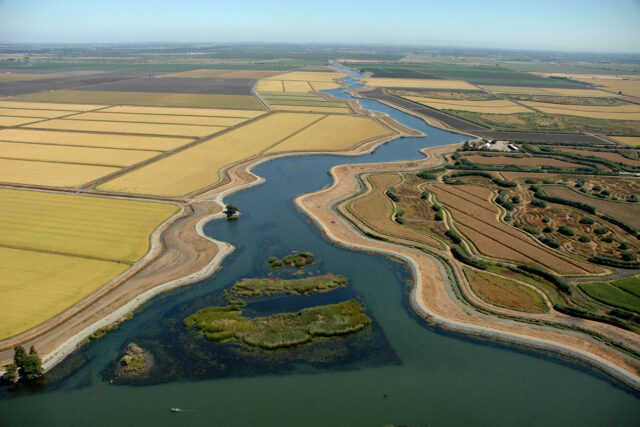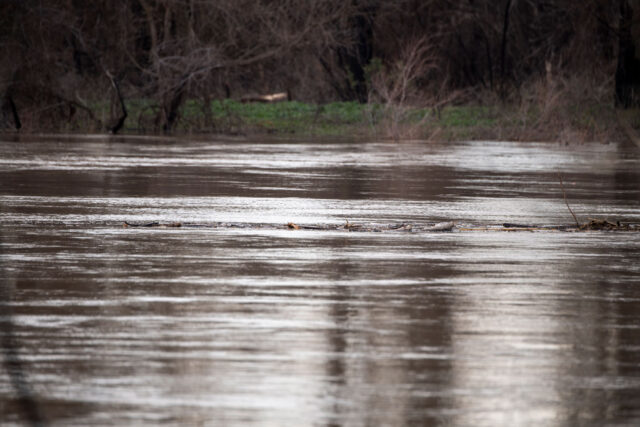Highlights
- The Sacramento–San Joaquin Delta and its watershed supply water to cities and farms across much of California; they also support commercial and recreational fisheries and provide vital habitat for many endangered native fishes and other aquatic species.
- During dry periods, most of the outflow from the Delta into San Francisco Bay is required to keep the Delta fresh enough for agricultural and urban uses, while during wet periods, most outflow is runoff that is too great to be captured and used.
- The climate in the watershed is changing: the past two decades have seen record warmth, making droughts more intense, with higher evaporation and declining snowpack. Water use upstream of the Delta appears to be rising, resulting in less inflow to the Delta.
- To address declining ecosystem health, regulations have also been changing, leading to higher outflows and lower water exports to other regions. These changes have not stopped the decline in native species.
- To better cope with more intense droughts, management of the Delta and its watershed would benefit from a suite of improvements in water use tracking and oversight, updates in water flow and quality regulations, and cost-effective investments to store more water in wet years.
The Delta is important to all Californians
The Sacramento–San Joaquin Delta lies at the confluence of two of the state’s largest rivers and at the head of the San Francisco Estuary. Forty percent of California’s runoff comes from the Delta watershed. It supplies water to roughly 30 million residents and more than 6 million acres of farmland upstream of and within the Delta, as well as in other watersheds including the Bay Area, the southern San Joaquin Valley, the Central Coast, and Southern California. The ecological health of the Delta and the reliability of its water supplies are in decline. Given the challenges facing the watershed and the competing uses for scarce supplies, Delta water management issues are a source of conflict and many misunderstandings about water use. Weak water accounting systems make this worse.
Runoff in the Delta watershed has many destinations
Surface water available in the Delta watershed in any given year can be broken down into three broad categories:
- Water sources. Rain and snow in the headwaters, along with rainfall in the valley and the Delta, generate runoff. The volume of runoff varies dramatically between wet and dry years, with frequent droughts and occasional floods (see first figure). Upstream reservoirs change the runoff available in any given year by storing water in wet years and releasing it in dry years—such as 2021 (see second figure).
Water availability and uses in the Delta watershed have been changing
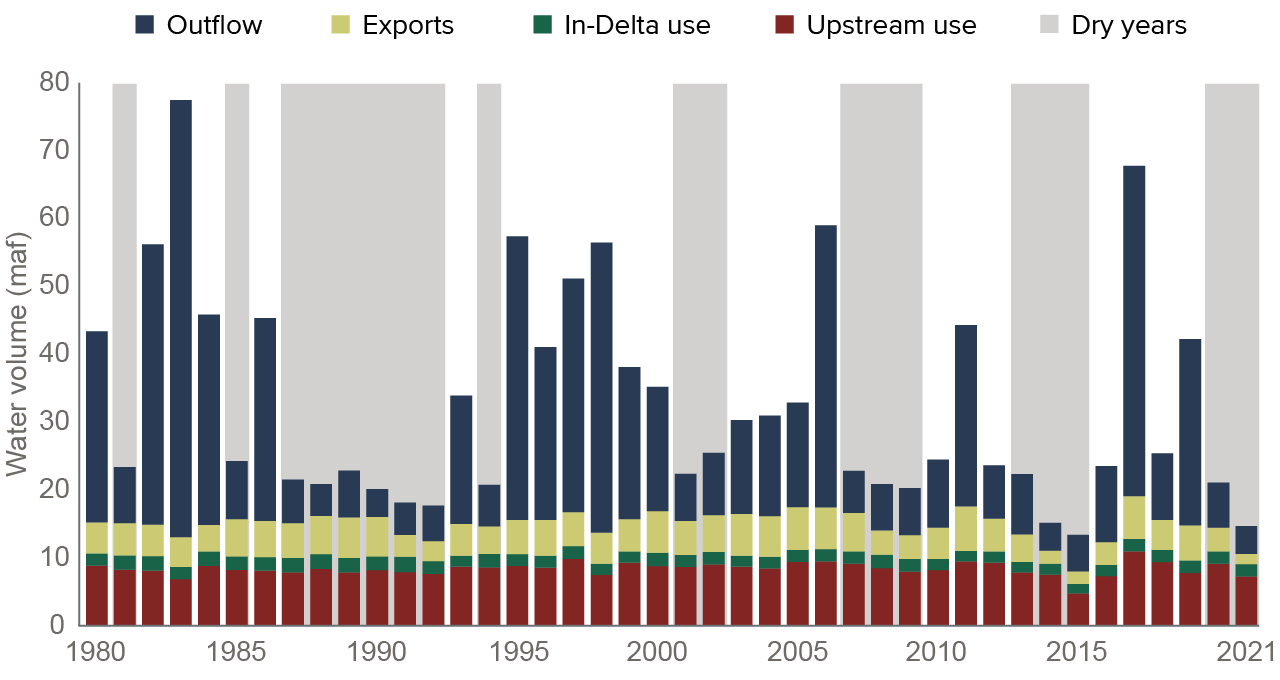
SOURCES: Uses and outflow: Technical Appendix to this report and PPIC Delta Water Accounting spreadsheets; dry years: Department of Water Resources.
NOTES: Upstream and in-Delta uses (or “depletions”) include net water diversions, water consumed by natural vegetation, channel evaporation, and net increases in groundwater storage. In-Delta uses include the legal Delta and diversions by the North Bay Aqueduct and the Contra Costa Canal. Exports are diversions by the Central Valley Project and the State Water Project. Upstream uses include out-of basin diverters in the Tulare Lake basin (Friant project) and the Bay Area (East Bay Municipal Utilities District and San Francisco Public Utilities Commission). Dry years are those classified as critical or dry in the Sacramento Valley based on the California Cooperative Snow Survey. Because this classification factors in the amount of runoff from the previous year, a single below-average year is often not classified as dry.
- Water uses. Most water use takes place upstream of the Delta, principally for farms, cities, wetlands, and groundwater recharge. Runoff that enters the Delta is used by farms, cities, and habitat within the Delta, and by farms, cities, and wetlands that receive exports from the Central Valley Project (CVP) and State Water Project (SWP). In-Delta water use does not vary much between wet and dry years; upstream use goes up some in wet years—such as 2017—when groundwater recharge is high. Exports vary the most: they are greatest during wet years and reach a low in very dry years—such as 2021 (see second figure).
- Delta outflow. A significant portion of runoff in the watershed becomes outflow into San Francisco Bay:
-
- Some outflow, referred to here as “system outflow,” is needed to repel seawater from the Delta at all times. Without it, Delta water would be unusable by cities and farms. In dry periods, reservoir releases are needed to keep salinity low enough. System outflow also supports the Delta ecosystem, but this outflow would be needed to keep water usable, even if there were no ecosystem management objectives in the Delta.
-
- Regulations ensure additional outflow to protect the ecosystem and several species of endangered fish. During dry periods, this “ecosystem outflow” is small compared to the outflow needed to maintain salinity, but during wetter years, outflow for the environment increases.
-
- Finally, during most years, there are periods when runoff exceeds the capacity of infrastructure to divert and store it. This “uncaptured outflow” becomes quite large during wet years (see second figure).
-
Tracking water sources, water uses, and Delta outflow in this watershed requires sophisticated water monitoring and accounting systems. Despite some recent improvements, information on some key measures—such as upstream use—is still very limited. This is important because our analysis indicates that water use upstream of the Delta is increasing.
The watershed is experiencing important changes in runoff and water use
The climate of the Delta watershed is changing, with a significant rise in temperatures over the past few decades. California also has been in a relatively dry spell, following a spate of wet years in the late 1990s (first figure). Warming is increasing “evaporative demand”—or what can be thought of as the “thirst of the atmosphere”—making droughts more intense. Warming is also causing significant declines in snowpack, historically a key part of the watershed’s seasonal water storage. These changes are impacting water sources, uses, and outflow—and posing major challenges for water supply managers, fish and wildlife managers, and state and federal regulators. Five key trends have emerged:
- Upstream use is rising—and Delta inflow falling. Upstream uses appear to be rising as a share of runoff in the Delta watershed in dry and critically dry years. In 2021, upstream uses accounted for a record 84 percent of runoff from the watershed. This shift is reducing inflows to the Delta, making it harder to meet other management objectives. While it is likely that increased evaporative demand is playing a role, it is not possible to determine the causes of increased upstream water use under the current monitoring system (e.g., drier and thirstier soils, more diversions, more reductions in river flows caused by higher groundwater pumping).
- Maintaining salinity is requiring more outflow. During the early 1990s, conditions seem to have changed in the Delta, requiring greater system outflow to meet salinity standards. The reasons are not well-documented, and research is underway to improve the understanding of trends, including estimates of in-Delta use and outflow and how they relate to salinity control. When system water needs increase, this puts increased pressure on upstream reservoirs, which must release more water to meet this higher outflow demand. Looking ahead, studies indicate that changes such as sea level rise, the creation of new tidal habitat in the western Delta, and other factors may lead to the need for more system outflow.
- Environmental regulations have also increased Delta outflow. During much of the last century, outflow was declining as water use grew. In the mid–1990s and 2000s, regulations on water flow and quality were expanded—and export pumping limits were set—to improve ecosystem health and protect endangered species. These changes have reduced exports in most years and increased outflow in dry years. In combination, increased outflow to meet salinity standards and protect the ecosystem has broken the long-term decline in the portion of runoff that becomes Delta outflow. Despite these changes, populations of many native species and the health of Delta ecosystems continue to decline.
- Dry year management increasingly relies on emergency measures. Eight of the last 10 years have been relatively dry; 2013–15 was the driest and hottest three-year period on record, and 2020–22 is on pace to equal or exceed that. In several of these years, the hot conditions and declining snowpack have significantly thrown off spring runoff forecasts—a crucial metric for managing supplies in dry years. Competing needs in the Delta include supplies for public health and safety and senior water right holders, cold water for salmon, and low salinity for water supply and species. Managing these competing needs has required gubernatorial drought emergency declarations, a relaxation of standards, and the installation of a temporary rock barrier in the Delta to reduce the amount of outflow needed to keep salinity low. Climate modeling suggests that wetter periods are likely to occur in the future, but hot conditions, increasing drought intensity, reduced snowpack, and changing patterns of runoff are here to stay.
- Wet years are increasingly important for supply. Even in extended dry periods, wet years still occur and are vital for supply. During very wet years, a large volume of water is uncapturable, and insufficient capacity to store water south of the Delta becomes a limitation on export pumping. Expanding above- and below-ground storage capacity could increase Delta exports without changing current regulations. In such years, more water could also be captured and stored upstream. Managers also need to adapt how they manage water storage in the watershed in a warming climate, where the snowpack is storing less water than it has historically.
Comparing Delta flows in wet and dry years
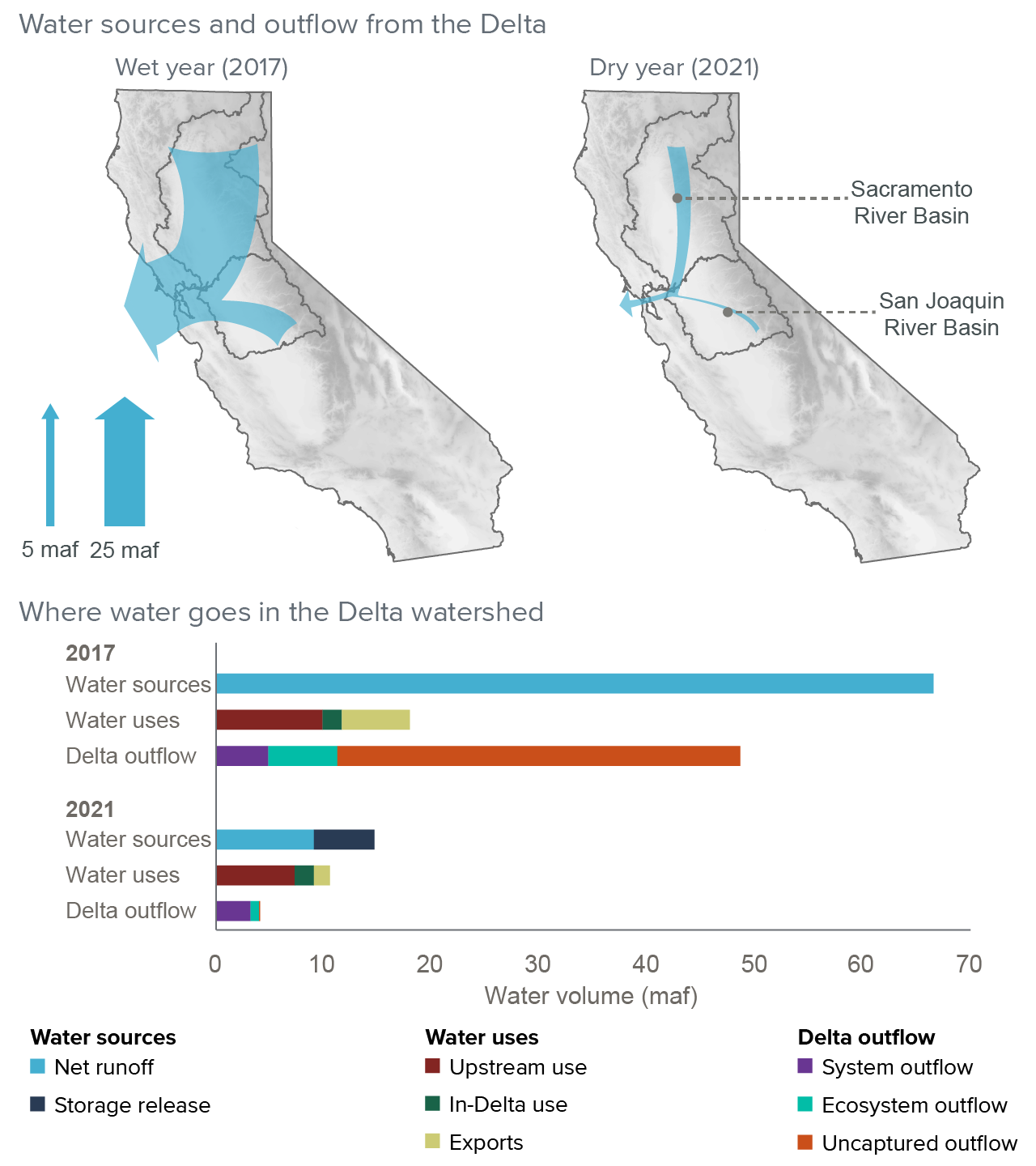
SOURCE: Technical Appendix to this policy brief and PPIC Delta Water Accounting spreadsheets.
NOTES: Maf is millions of acre-feet. The figures show Delta watershed flows in water years (October 1 through September 30). Map arrows show runoff from the Sacramento and San Joaquin River basins and outflow from the Delta, and are approximately to scale. Bars show the composition of sources, uses, and outflow. Net runoff is total runoff plus Delta precipitation minus net increases in surface storage (in 2017, 3.7 maf). Values for 2017 and 2021 (all in maf) are as follows: net runoff (66.6, 9.1); storage release (0, 5.6); upstream use (9.9, 7.3); in-Delta use (1.8, 1.8); exports (6.3, 1.5); system outflow (4.8, 3.2); ecosystem outflow (6.4, 0.8); uncaptured outflow (37.4, 0.1). Imports from the Trinity River (0.6 maf in both years) contributed to net changes in storage. See text and notes in the first figure for definitions of uses and outflow categories.
Takeaways for water policy and management
The severe drought that California is now facing—coming so soon on the heels of the record-breaking 2012–16 drought—underscores the importance of adapting water management in the Delta watershed to the changing climate. Important progress has occurred, but more can be done.
- Continue to improve water accounting. Some significant advances in water accounting have been launched since the last drought, including better reporting of surface water diversions under Senate Bill 88 (2015) and better tracking of groundwater use under the Sustainable Groundwater Management Act (2014). Still needed are more frequent and accurate tracking of upstream and in-Delta diversions, along with explicit tracking of the water that returns to rivers and streams as discharges and irrigation runoff. These improvements are essential for tracking scarce supplies and responding effectively to drought in the Delta and its watershed. Technologies are available to help implement these improvements cost-effectively.
- Integrate planning for severe droughts into regular management practices. Within this watershed, water managers and regulators rely heavily on data from the historical hydrologic record to plan and forecast operations and to set regulations. But today’s warmer, more intense droughts fall outside the bounds of historical conditions, and reliance on emergency measures to manage drought is now commonplace. To improve response capacity, the state should pivot toward more routine practices for managing severe drought. This includes adapting forecasting to better capture current drought conditions (an effort now underway); developing decision trees to help anticipate situations and prescribe possible actions as the season unfolds; improving the ability to curtail diversions with precision, including for senior water right holders; and considering installation of a permanent, operable barrier in the Delta to better manage salinity.
- Modernize and simplify regulations to provide water for the environment. The current mix of state and federal regulations is unnecessarily rigid, not well coordinated, and not always logical. Two efforts now underway—the State Water Board’s comprehensive revision of its water quality control plan for the Delta, and endangered species consultations governing CVP and SWP operations (e.g., Biological Opinions, Incidental Take Permits)—provide an opportunity to coordinate and simplify regulations, and to increase flexibility to help both environmental water managers and water users respond to rapidly changing hydrologic conditions. One central change needed is to pivot from a system based on water year types—where regulatory requirements can change abruptly with subtle changes in conditions—to a system that operates on a continuum based on month-to-month hydrology.
- Prepare for wet years. Increasing the amount of water stored during wet periods—whether by taking more water out upstream of the Delta, or making the best use of export facilities—has to be done with care for the environment and other water users. But it is possible to do a better job of storing water during wet years—both above and below ground—without doing harm. Improving the management of wet-year supplies is a critical climate change adaptation strategy. This will require identifying cost-effective investment options and adapting operations and regulatory approaches to facilitate capturing more water in wet times.
- In very dry years, upstream and in-Delta uses consume most of the water in the watershed; in 2021, they used all available runoff, leaving water stored in reservoirs to meet export demands and water quality and flow standards.
- In very wet years, upstream and in-Delta uses consume less than 20% of runoff and exports account for 10%, leaving the remainder (70%) as outflow.
- The annual amount of outflow needed to keep the Delta fresh for in-Delta use and exports varies relatively little in volume (3.5–4.9 maf), but during severe droughts it is four times the amount of outflow needed to meet environmental standards.
- In very wet years, outflow to protect ecosystem health and endangered species accounts for about 10% of all water available, whereas during severe drought it averages 6%.
- The CVP and SWP are required to meet outflow requirements for salinity and ecosystem protection. But these requirements do not always result in corresponding declines in exports—especially in wet years when there is so much water in the system.
- Under current regulations, improving storage capacity south of the Delta would allow for 400,000 af or more of additional exports during wet years.
